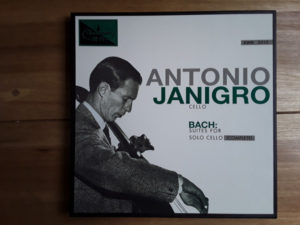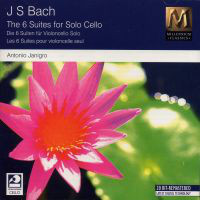

Antonio Janigro. Bach Cello Suites. Review using Tidal streaming (hi fi) of DOREMI DHR 8014-6. Original recordings on Westminster 1953-57.
No information retrieved regards venue.
Web site visitor, Salverio Soldani reports that cello used was by Giambattista Guadagnini from 1769. The info comes from former pupils of Maestro Janigro.
Introduction.
Highly respected Italian cellist Antonio Janigro died in 1989. He succeeded both as conductor and teacher as well as soloist. I would recommend auditioning Enrico Dindo’s recording of the Suites. He was a pupil and fellow countryman of Janigro.
Due to the war, in the 1940s Janigro found himself forced to stay in Yugoslavia. Holidaying when hostilities broke out, the restrictions stranded him in much the same way as the current Covid outbreak ! Clearly, keen to keep active, he spent the war setting up a firm foundation of cello playing and chamber music in Yugoslavia. It would appear that Janigro made this his second home and in fact the internet details celebrations in Zagreb of his birthday centenary in 2018. The Yugoslavs clearly took to Janigro!
Its worth checking out the internet for his list of mentors and pupils which reads like a who’s who!
The Recording.
This Doremi remastering is excellent, no doubt due to the outstanding original Westminster recording. Original mono LP recordings are available at very modest prices. In similar vein to the Mercury Living presence recordings of Starker in the early 60s, a single very high-quality microphone was used.
The end result is a wonderful tone, covering the whole frequency range especially lower end, well. The acoustic is open and airy, and the cello positioned perfectly for me at least. There are occasional noises but nothing intrusive. Dynamics are well captured. It would have been easy on blind listening to have placed this recording in the 70s.
The Music.
In much the same way that the recording sounds more recent than it is, the interpretation is remarkably contemporary. Yes, there is the very occasional hint of a glissando or portamento. However, vibrato is sparing or very fast so as to be unnoticed much of the time. The tone is often strong with sustained legato passages especially in the Sarabandes. However, the playing in faster movements is rhythmic and very well-articulated. To be more specific, there are none of the quirky speed choices common to earlier recordings. There is no exaggerated emphasis of key notes or marked rubato. Some performances of the 50s and 60s do sound postured or overly dramatic. None of that here, as Janigro plays in what sounds like a very honest, musical manner with deference to the composer.
Although much of the recording will have been done in a single take, the tuning is invariably pin point accurate. One bizarre exception to this is the last note of the fifth Gigue which leapt out and jarred. It may have been intentional but check it out and see what you think.
My favourite movements of these performances were the Courantes. There is great use of dynamics and some interesting phrasing which brings out elements of the melody most other performers seem to miss.
The fifth movements were mostly well contrasted between the first and second dance. Allemandes were very expressive without huge liberties with timing.
With the exception of the ponderous fourth Prelude, these first movements were imposing, well phrased and flowed well. The technicalities of the fifth and sixth Suites were very well handled. Janigro resists the temptation to impress with speed. Instead, he provides sustained interest with phrasing and dynamics.
Conclusion.
Overall this is my current preferred recording from the early era which I would suggest covers up to 1970. It has the bonus of being obtainable in original form and CD at reasonable prices. Quite an unexpected find!
Charles.